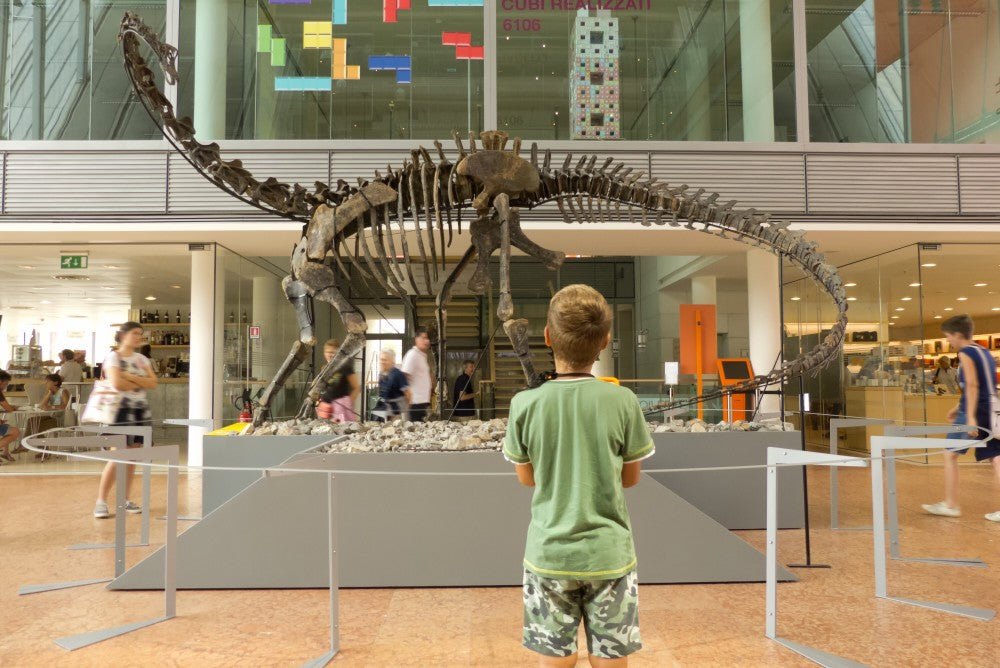
Understanding Different Types of Fossils
Have you ever wanted to give or receive a gift so unique, one-of-a-kind, and a part of natural history? Fossils represent a piece of prehistoric history. Whether you are a fossil enthusiast or just fascinated by these old and ancient relics, everyone can appreciate fossils and remember the creatures that left their mark in a time long, long ago. This comprehensive guide will discuss all of the beauty, wonder, and history of these types of fossils: shark teeth, trilobites, and ammonites.
You do not need to take a magical trip in a time machine to get your hands on these ancient artifacts - shop the Hawaiian gift shop at Whaler's Locker for these rare finds. Before we dive into the difference between mold fossils and cast fossils, we will first recall how these ancient relics were able to preserve themselves over millions of years so we can study and enjoy them in the present day.
The Process of Fossilization

Have you ever wondered how we can know so much about ancient animals and organisms? Fossilization is the process of preservation of an organism that occurs naturally. The process of fossilization is rare and only occurs under the right conditions, so it is a wonder that we can learn so much about the organisms that roamed in prehistoric eras. Paleontology tells us so much about the formation, age, and evolution of different fossils. There are many different types of fossilization processes and fossils that can naturally form and occur, including mold fossils. Fossilization can preserve teeth, hard bones, shells, or impressions. Without this natural process of preservation, we would not know a lot about our ancient world.
All About Fossils
Many preservation processes occur under fossilization, with the most common type being mineralization. Mineralization occurs when the soft parts of an organism decay and minerals replace those vacant spaces, allowing preservation. In this guide, we will explore the process of four distinct types of fossils and how they come to exist.
Different Types of Fossils
- Mold fossils
- Cast fossils
- Trace fossils
- True form fossils
No matter what type of fossilization process you study, each scenario involves the decay, transport, and burial of specific organisms. Even with mold fossils and cast fossils, it takes researchers years of discovery and study to conclude how ancient organisms lived before our time. Without the presence of fossils, we would not know nearly as much about the prehistoric world as we do today.
Mold Fossil Impressions

Mold fossils are one type of fossil preservation that occurs when all or part of an organism leaves an impression onto some natural surface, like a porous rock. The impression is preserved and shows us the negative image of the organism that creates a mold fossil.
When minerals fill the impression and harden, this impression is a mold fossil. Some common types of mold fossils include bones, teeth, and claws. Mold fossils can include the exterior, interior, and shell of an organism.
Mold fossils serve as windows to the past and allow us to learn more about left-behind and extinct organisms. Once there is a presence of a mold, a cast fossil can naturally occur.
Three-Dimensional Cast Fossils
Cast fossils are similar to mold fossils in that a three-dimensional impression is left behind from an organism. In a cast fossil, the mold fills with some other mineral, hardening the impression. Both cast and mold fossils allow us to view the different and intricate contours of various organisms left behind. One example of a cast fossil is a trilobite, which we will deep dive into later on. Body fossils can include cast and mold fossils through casts, a replica of the animal or organism is created and preserved.
Organism Trace Fossils
When an animal leaves behind remnants of its existence and not the actual organism itself, we call these trace fossils. Unlike cast fossils and mold fossils, some animals' physical traces are left behind with trace fossils. The most common type of trace fossil is the dinosaur footprint, but other trace fossils can include nests, embryos, and burrows. In footprints, the trace fossil is left in mud or dirt and then covered in another sediment layer. The sediment becomes compacted, and over time becomes hardened. The hardened sediment protects and preserves the trace fossil underneath.
True Form Fossils

The most well-kept and well-preserved parts of an animal, like a frozen mammoth, are referred to as true form fossils. These types of fossils are remnants of the physical animal or their parts. While mold fossils give us a close idea of the formation of ancient organisms, authentic form fossils give us the purest information of prehistoric creatures. These fossils exist due to a process called petrification. Like other fossilization processes, petrification results from some organic part of an organism decaying. Once that part has decayed, minerals and other natural materials will replace the organism's now-vacant area or plant-life. An example of petrification is wood that falls from trees and buries under dirt and other sediments. Once underground, silica and other minerals replace some of the wood material, turning it into petrified wood.
Fossils at Whaler’s Locker
Whether it be a cast fossil, mold fossil, or a trace fossil, we carry many different types of fossils at Whaler’s Locker. Whether you seek remnants of ancient ocean-dwellers or the shells of prehistoric cast fossils, we have you covered with a wide variety of fossils. Here are some of the fossils that we carry that are readily available for purchase:
- Shark teeth of several varieties
- Ammonites
- Trilobites
With price points starting as low as $10, you will be sure to find a fossil that fits your desired size and price point at our unique gift shop. Whether you'd like to wear these bold pieces like jewelry or use them to add unique decor to your home, we can all agree that these one-of-a-kind fossils are a unique statement piece. From shark teeth to coil-shaped organisms, mold fossils to cast fossils, and more, explore our intricate and rare fossil collection.
A Variety of Shark Teeth
At Whaler's Locker, we have more than five varieties of shark teeth fossils. You wouldn't usually think of shark teeth as tiny, but some of the smallest shark teeth we have come in at just a half an inch wide, like our Tiny Tiger tooth variety. If you're a collector looking for your next massive piece, our Megalodon collection boasts a variety of 4-6 inch teeth that will be sure to catch anyone's eye. With polished and untouched options, there are so many shark teeth fossil varieties to explore, so let's dive in!
Shark Teeth: Megalodon
Megalodon sharks were a gigantic apex predator before their extinction around 20 million years ago. These unique and massive shark teeth are a collector's dream, but anyone with an appreciation of natural history can admire these cast fossils. With sizes up to 6.25 inches, you can compare the size of these massive Megalodon shark teeth in your hand - if they will fit! These Megalodon teeth come from all over the world, including Florida's Bone Valley. You will find a shark tooth fossil that suits you - browse our Megalodon teeth, which is our most extensive collection of shark teeth to date. If you need help getting started, check out our most popular megalodon teeth.
Shark Teeth: Parotodus Benedeni
Roaming over five million years ago, the Parotodus are an extinct ocean creature whose remnants are rare. Scientists and researches know little about this ancestor of the Mackerel shark, also called the False Mako shark. The Parotodus teeth have very distinct characteristics, which help paleontologists to confirm it's species of origin. You don't have to hunt the shorelines of beaches across the world to find one of these rare and beautiful shark teeth.
The Parotodus Benedeni teeth suggest an evolutionary design for thrashing with their thick, triangular shape, massive in size. These teeth are often grey, brown, beige, and black due to the minerals, dirt, and sediment surrounding the tooth as it undergoes fossilization. Our Parotodus fossil collection boasts unique turquoise and pyrite inlays, so you don't want to miss out.
Other Shark Teeth Fossils
While there are plenty of cast fossils to choose from with Parotodus and Megalodon teeth, we carry varieties of other shark teeth as well. Our shark teeth fossils serve as a representation of extinct and rare creatures. These teeth tell us so much about how these animals lived, evolved, and died. Check out more varieties of our favorite cast fossils, shark teeth:
- Bull Shark
- Tiny Tiger Shark
- Great White Shark
- Otodus Obliquus
- Carcharocles Sokolovi
So many of our shark teeth fossils come as pendants and give you the option to adorn these relics as a unique jewelry piece. You can purchase this pendant on its own or with any of our chains and cords. Whether you choose a shark tooth pendant or stand-alone fossil, these ancient relics are sure to strike up a conversation about the beauty and wonder of the allure of ocean creatures.
Ammonite Shell Fossils
Ammonite fossils form when organisms’ shells fill with surrounding sediment to create a cast. These prehistoric mollusks evolved to develop thick shells that protect their soft invertebrate from predators. These organisms dwelled on shallow ocean floors but were able to move about through water propulsion, which was also a characteristic of their outer shell. The unique patterns of ammonite fossils, mainly shown in split shells, make these common fossils so intricate. Ammonite shells tell us so much about these ancient organisms - from their defense mechanisms to evolution habits.
Trilobite Cast Fossils
Trilobite fossils are similar to ammonite fossils in that they are both the product of cast fossils. Trilobites are hard-shelled arthropods that were exclusively sea inhabitants. Though now extinct, we can learn about trilobites through the cast fossils they leave behind. These invertebrates would use their protective shell to shape themselves into a ball as a defense mechanism. Our trilobite fossils are sourced from the Anti-Atlas Mountains of Morocco but exist in fossil form on every continent. See the beauty of these organisms through the cast fossils left behind.
Unique Fossil Gifts
Fossils are a one-of-a-kind piece of natural history, which is why they make the perfect gifts. Fossilization takes thousands of years but only moments to enjoy and appreciate. We have more than just fossils to offer - here is a short gift guide that helps give you an idea of the variety of products we carry at Whaler’s Locker:
- Atlas Mountain Jasper Stone
- Fossil Shark Tooth Surfboard Shaped Keychain
- Scrimshaw Cuff Links
- Baltic Amber Rings
- Ammonite Pendant
From mold fossils to cast fossils and everything in between, we want to help you find a special gift for everyone on your shopping list. With so many different types, sizes, and price points within our fossil collection, you can find even the most eccentric and colorful relics. If you want to start small, browse our fossil gifts that are $40 or less.
Shopping for Rare Fossil Finds
When shopping at our unique gift shop, there’s very little chance of someone else gifting the same item as you. With rare, one-of-a-kind pieces like our healing power crystals and ancient relics, there are plenty of reasons to see why the Whaler's Locker items make excellent gifts. Our pieces are conversation-starters that can add interest to any ensemble or spruce up your living space.
Fossils give us the chance to explore, learn, research, and appreciate the prehistoric organisms that existed millions of years ago. No matter how big or small, fossils carry a piece of ancient natural history with them and should be appreciated for yourself or as gifts to others. If you're looking for a one-stop-shop that carries an array of niche items to start your fossil collection, visit our Hawaiian gift shop.



